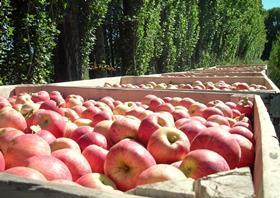
Argentina’s 2011 fresh apple, pear, and table grape production is estimated to increase significantly due to favourable weather conditions (which have resulted in higher yields) and new plantations entering production, especially for apples and pears.
According to a report by the USDA, the apple crop will rebound to 990,000 tonnes in 2011, while pears will reach 790,000 tonnes with table grapes hitting 145,000 tonnes.
Exports are projected to rise as a result, with apple sendings set to increase to 230,000 tonnes (up from 180,000 tonnes in 2010), pears to 460,000 tonnes (compared with 370,000 tonnes), and table grapes to 60,000 tonnes (an increase on 55,000 tonnes).
Currently, Argentina exports apples and pears to over 60 markets, according to the USDA.
Brazil continues to consolidate its position as the most significant market, especially for pears, followed by Russia.
The USDA said Brazil’s importance is due primarily to the relatively high value of the real against the US dollar, as well as Brazil’s flexibility (regarding the quality of fruit it imports) compared with the European Union (EU) and the US.
During the period January-July 2010, however, Russia became the leading export market (in volume terms) for Argentinean apples, while Brazil remained the major destination for pears.
Algeria was the third export market for Argentinean apples in 2009, almost doubling its imports compared with 2008.
The main export destination for Argentinean table grapes is the EU, which absorbed 26,000 tonnes in 2009, although in the January-July period of 2010 Brazil became the largest export market, followed by Russia.
In 2011 the USDA predicts Argentinean grape suppliers will continue to focus on traditional markets, such as the EU, Russia, and Brazil, while local exporters will also work on developing other non-traditional Latin American markets.
Organic fresh apple and pear production, destined for niche export markets, has also been growing steadily during the past few years, the USDA said.
This comes despite organic production costs being 30 per cent higher than conventional production, primarily due to the manual pruning of fruit trees (production costs for organic apples and pears have increased by over 350 per cent since 2001).
Also, the global economic and financial crisis has negatively affected organic fruit consumption in Argentina’s high-value fruit export markets (such as the EU and the US), but the recent resumption of organic imports is expected to continue to grow gradually in the future.
The USDA estimates that about 85-90 per cent of Argentina’s total apple production and approximately 80-85 per cent of its total pear production is produced in Rio Negro and Neuquen, while the balance is produced primarily in Mendoza.
For table grapes, the province of San Juan concentrates about 95 per cent of total table grape production in Argentina.



